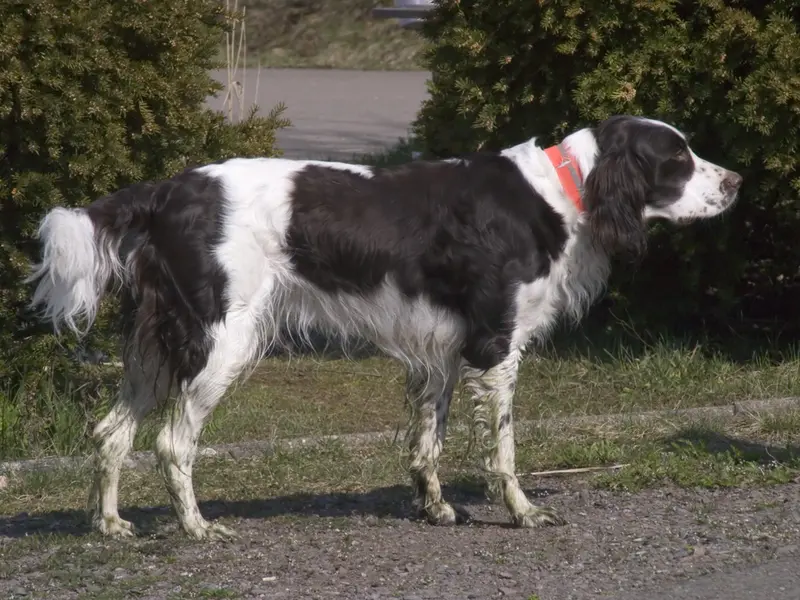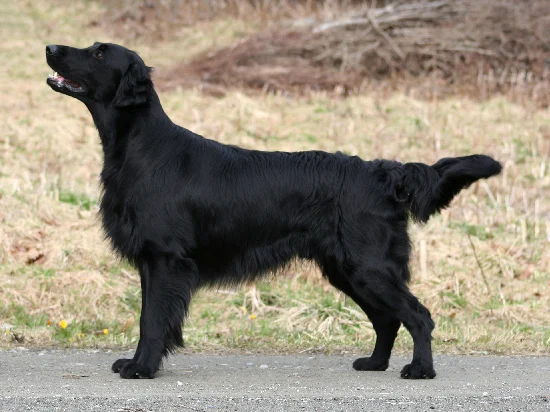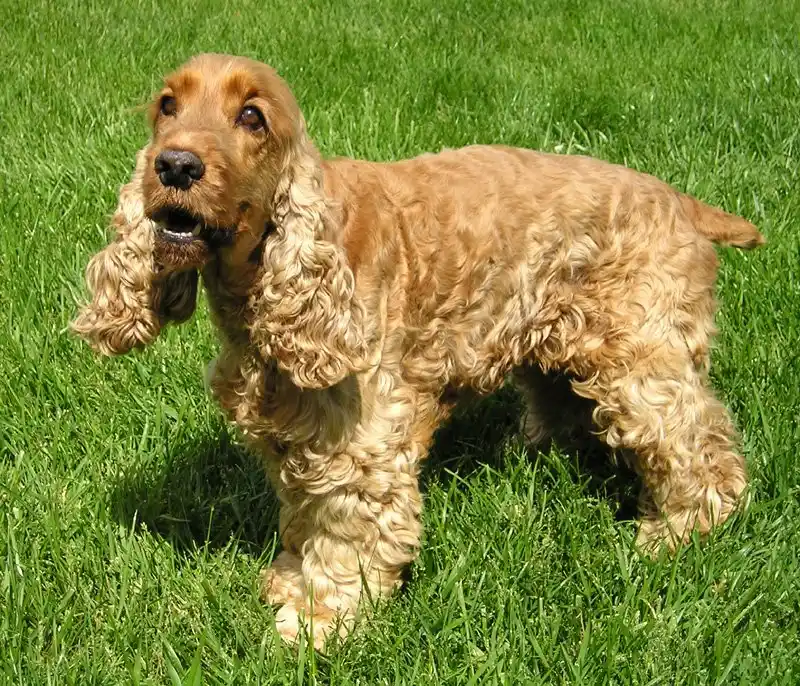English Springer Spaniel
The English Springer Spaniel is a medium-sized, affectionate breed known for its intelligence and versatility. With a strong work drive, they excel in hunting, agility, and as family companions.
Overview
🐕Breed Overview
✨Key Traits
💡What Makes English Springer Spaniel Special
The English Springer Spaniel is characterized by its strong work ethic and versatility. They excel in various roles, from hunting and retrieving to participating in dog sports and serving as loyal companions.
Their intelligence and eagerness to learn make them highly trainable, and they respond well to positive reinforcement techniques. This breed is also known for its affectionate nature, forming strong bonds with their families.
Their playful spirit and love for outdoor activities make them ideal companions for active households. Additionally, their friendly disposition allows them to get along well with children and other pets, making them a well-rounded family dog.
The English Springer Spaniel is a medium-sized sporting dog known for its friendly disposition and exceptional hunting abilities. With a height ranging from 19 to 20 inches and a weight of 40 to 50 pounds, this breed is compact yet sturdy, making it an ideal companion for active families and hunters alike. Their medium-length coat, which can be flat or wavy, comes in various color combinations, including liver and white, black and white, and tricolor.
These dogs are characterized by their affectionate nature, high energy levels, and eagerness to please, making them highly trainable and responsive to commands. Historically, the English Springer Spaniel was bred for flushing and retrieving game, and they excel in various roles, including drug detection and agility competitions. Their intelligence and versatility make them a popular choice among dog owners, while their friendly demeanor ensures they fit well into family life.
Regular exercise is crucial for this breed, as they require at least 60 minutes of physical activity each day to prevent boredom and maintain their health. Grooming needs are moderate, with brushing required a few times a week to keep their coat in good condition. Overall, the English Springer Spaniel is a delightful breed that thrives on companionship, activity, and a job to do, making them a cherished addition to any home.
🎉Fun Facts
Springers are one of the fastest spaniel breeds, excelling in agility and field trials.
The English Springer Spaniel is known for its exceptional swimming ability, making it a favorite among waterfowl hunters.
They are often used as detection dogs due to their keen sense of smell and trainability.
Breed Characteristics
Family & Friends
Good Behavior
Get Up & Go
Household Harmony
Temperament & Personality
✨Key Traits
🐕Core Temperament
The English Springer Spaniel is known for its friendly and outgoing temperament. They are eager to please and highly trainable, making them excellent companions for families and individuals alike.
Their playful nature and love for interaction make them great with children, while their sociable demeanor allows them to get along well with other pets. They are generally calm and affectionate, but they require regular exercise to channel their energy positively.
Without adequate physical and mental stimulation, they may become bored and exhibit undesirable behaviors. Overall, their gentle and loving temperament makes them a cherished addition to any household.
💫Personality Profile
The English Springer Spaniel is a cheerful and playful breed, known for its affectionate nature and eagerness to please. They thrive on human interaction and are highly social, making them excellent family companions.
Their energy levels are moderate to high, requiring regular exercise and mental stimulation to keep them happy and well-behaved. They are friendly with both children and other pets, displaying a gentle demeanor that makes them suitable for family life.
However, they can become overly enthusiastic if not properly exercised, leading to potential behavioral issues. Overall, their loving and playful personality makes them a joy to have around.
🔊Vocal Tendencies
English Springer Spaniels are moderately vocal and may bark to alert their owners of strangers or when they are excited. They are not known to be excessive barkers, but their friendly nature may lead them to bark when greeting people or during play.
Their vocalizations can vary from playful barks to soft whines, especially when they seek attention or companionship. Proper training and socialization can help manage their barking tendencies, ensuring they are well-mannered in various situations.
Affection & Social Traits
Energy & Activity
Communication Style
Care Requirements
🏃♂️Exercise Requirements
Daily Exercise
The English Springer Spaniel is a highly active breed that requires a significant amount of daily exercise to maintain its physical and mental well-being. Ideally, they should engage in at least 60 to 90 minutes of exercise each day. This can include a combination of brisk walks, runs, playtime in a secure yard, and engaging in dog sports such as agility or obedience training.
Activities that stimulate their natural instincts, such as fetching, swimming, and hunting, are particularly beneficial. Puppies may require shorter, more frequent exercise sessions to accommodate their developing bodies, while senior dogs may need gentler activities to avoid strain. Regular exercise not only helps manage their weight but also reduces the likelihood of behavioral issues stemming from boredom or excess energy.
Insufficient exercise can lead to destructive behaviors, anxiety, and obesity, making it crucial for owners to prioritize their exercise needs.
Preferred Activities
🏠Living & Adaptability
Space Requirements
English Springer Spaniels thrive in environments where they have ample space to run and play. While they can adapt to apartment living, it is essential that they receive sufficient daily exercise and mental stimulation.
Ideally, they should have access to a medium to large yard where they can explore and engage in activities. In smaller living spaces, owners must commit to regular outings and exercise sessions to prevent boredom and destructive behavior.
Their energetic nature means that they do not do well when confined for long periods, so a secure outdoor area is beneficial for their happiness and well-being.
Climate Preference
🍲Feeding Guide
Schedule
Food Types
Portion Size
Special Nutritional Needs
English Springer Spaniels may benefit from a diet rich in protein and healthy fats to support their active lifestyle. It's important to monitor their weight, as they can be prone to obesity. Regular veterinary check-ups can help identify any specific dietary needs or sensitivities.
✨Grooming Requirements
Grooming Overview
The English Springer Spaniel has a medium-length coat that requires regular grooming to keep it healthy and free from mats. Brushing should be done at least once a week to remove dead hair and prevent tangles, especially in the feathered areas on the ears, chest, legs, and belly.
Bathing should be done as needed, typically every few months or when they get particularly dirty. Regular trimming every two to three months will help maintain a neat appearance and manage their coat's length.
Pay special attention to their ears, as they are prone to infections; cleaning them regularly will help prevent issues. Additionally, regular nail trimming and dental care are essential for overall health.
Care Schedule
Brush weekly, bathe as needed (every few months), and trim every two to three months.
Health Profile
⚕️Health Care
Regular health care is vital for the English Springer Spaniel's lifespan. Routine veterinary check-ups, vaccinations, and preventive treatments can help detect health issues early and ensure that the dog remains healthy throughout its life.
Regular dental care, including brushing and professional cleanings, is also important to prevent dental disease. Maintaining a healthy weight through proper diet and exercise is crucial, as obesity can lead to various health problems.
By prioritizing health care and preventive measures, owners can significantly enhance their dog's quality of life and longevity.
Health Issues Overview
⏳Average Lifespan
Genetic Factors
Genetics plays a crucial role in the lifespan of the English Springer Spaniel. Certain hereditary health issues, such as hip dysplasia and progressive retinal atrophy, can impact their quality of life and longevity.
Responsible breeding practices that prioritize genetic health can help reduce the prevalence of these conditions. Potential owners should seek out breeders who conduct health screenings and genetic testing to ensure they are getting a healthy puppy.
Understanding the genetic background of the breed can help owners make informed decisions and take proactive measures to maintain their dog's health throughout its life.
Living Conditions
The English Springer Spaniel's lifespan can be influenced by various environmental factors, including housing conditions, climate, and social interactions. Dogs that live in active households with plenty of opportunities for exercise and mental stimulation tend to live longer, healthier lives.
Access to a secure outdoor space for play and exploration is essential, as is regular interaction with family members. Additionally, a balanced diet and routine veterinary care contribute significantly to their overall health and longevity.
Exposure to extreme temperatures should be managed, as these dogs can be sensitive to both heat and cold. Overall, providing a nurturing and engaging environment is key to promoting a long and healthy life for this breed.
🏥Common Health Issues
Hip Dysplasia
Warning Signs
🔬Diagnosis
X-rays and physical examination by a veterinarian.
💊Treatment
Surgical options or medication for pain management.
📝Management Tips
Maintain a healthy weight, provide joint supplements, and avoid excessive exercise during growth periods.
Progressive Retinal Atrophy (PRA)
Warning Signs
🔬Diagnosis
Ophthalmic examination by a veterinary ophthalmologist.
💊Treatment
No cure; supportive care and environmental modifications.
📝Management Tips
Regular eye check-ups and monitoring for vision changes.
Ear Infections
Warning Signs
🔬Diagnosis
Physical examination and ear swab by a veterinarian.
💊Treatment
Antibiotics or antifungal medications as prescribed by a veterinarian.
📝Management Tips
Regular ear cleaning and monitoring for signs of infection.
🛡️Preventive Care
🔬Hip Evaluation
Hip Evaluation assesses the hip joints for dysplasia and other abnormalities, crucial for preventing arthritis and mobility issues.
📅 Annually, starting at 12 months of age.
🔬Eye Examination
Eye Examination by a veterinary ophthalmologist to check for hereditary eye conditions such as PRA and retinal dysplasia.
📅 Every 1-2 years, starting at 2 years of age.
🔬Elbow Evaluation
Elbow Evaluation to screen for elbow dysplasia and ensure joint health, important for active dogs.
📅 Annually, starting at 12 months of age.
Training
🧠Intelligence & Trainability
💪Work Drive
The English Springer Spaniel has a strong work drive and thrives when given tasks to complete. Their history as hunting dogs means they require mental and physical challenges to stay happy and healthy.
Activities such as retrieving games, scent detection exercises, and participation in dog sports like agility or obedience trials can fulfill their need for stimulation. Without adequate engagement, they may become bored and develop undesirable behaviors.
Providing them with a job, whether in the field or through structured play, is essential for their overall well-being.
⚠️Training Considerations
English Springer Spaniels are generally eager to please and highly trainable, but they can exhibit behavioral challenges if not properly managed. Common issues include excessive barking, jumping, and destructiveness when bored or under-exercised.
To overcome these challenges, consistent training and socialization from an early age are essential. Positive reinforcement techniques work best for this breed, as they respond well to praise and rewards.
Engaging them in regular training sessions and providing mental stimulation through puzzle toys or interactive games can help mitigate behavioral issues. Additionally, establishing clear boundaries and routines will aid in managing their energy levels and ensuring they remain well-behaved companions.
📝Training Tips
Training an English Springer Spaniel can be a rewarding experience due to their intelligence and eagerness to learn. Start with basic obedience commands such as sit, stay, and come, using positive reinforcement techniques to encourage good behavior.
Consistency is key; ensure that all family members use the same commands and rules. Incorporate fun activities like agility training or scent work to keep them engaged and mentally stimulated.
Socialization is also crucial; expose your Springer to various environments, people, and other animals to help them develop into well-rounded adults. Regular training sessions should be kept short and enjoyable to maintain their interest and enthusiasm.
History & Heritage
📜Origin Story
The English Springer Spaniel's origins can be traced back to the Roman conquests, where early spaniel-type dogs were brought to Britain from Spain. These dogs were favored for their hunting abilities, and as they adapted to the British landscape, they evolved into the distinct breeds we recognize today. The name 'spaniel' is believed to derive from the Roman term for Spain, highlighting the breed's historical roots.
By the late 1500s, references to land spaniels began to appear, indicating the breed's long-standing association with hunting. The English Springer Spaniel was developed as a versatile hunting companion, capable of flushing and retrieving game. The breed's popularity soared in the 19th century, leading to the establishment of breed standards and recognition by kennel clubs.
Today, the English Springer Spaniel is celebrated for its intelligence, trainability, and affectionate nature, making it a beloved choice for families and hunters alike.
⏳Development History
The English Springer Spaniel's history dates back to the 16th century when they were recognized as land spaniels. Initially, they were bred alongside cocker spaniels, with both breeds originating from the same litters.
The term 'springer' refers to their ability to flush game into the air, a skill that was highly valued by hunters. By the early 19th century, distinct strains began to emerge, with the Duke of Norfolk's breeding program significantly influencing the breed's development.
The English Springer Spaniel was officially recognized as a distinct breed by the English Kennel Club in 1902, and the American Kennel Club followed suit in 1910. Over the years, the breed has been refined for both show and field purposes, leading to the development of separate lines that cater to different needs.
🛡️Purpose & Historical Role
Originally bred for flushing and retrieving game, the English Springer Spaniel has played a crucial role in hunting for centuries. Their ability to work in dense underbrush and flush birds into the air made them invaluable to hunters before the advent of shotguns.
As hunting practices evolved, so did the breed, which adapted to various roles, including drug and bomb detection, search and rescue, and as loyal companions. Their intelligence and eagerness to please have allowed them to excel in various canine sports and activities, further solidifying their place in both working and family environments.
🏺Cultural Significance
The English Springer Spaniel holds a significant place in both hunting and family life, particularly in England where it originated. Historically, these dogs were bred for their exceptional abilities in flushing game, making them invaluable companions for hunters.
Their versatility has allowed them to excel in various roles, from working as drug and bomb detection dogs to serving as beloved family pets. The breed's friendly and affectionate nature has made it a popular choice among families, contributing to its cultural significance as a loyal companion.
Additionally, the English Springer Spaniel has been featured in various media and literature, further solidifying its status as a cherished breed.
Conservation Status
This breed is well-established with healthy population numbers.









